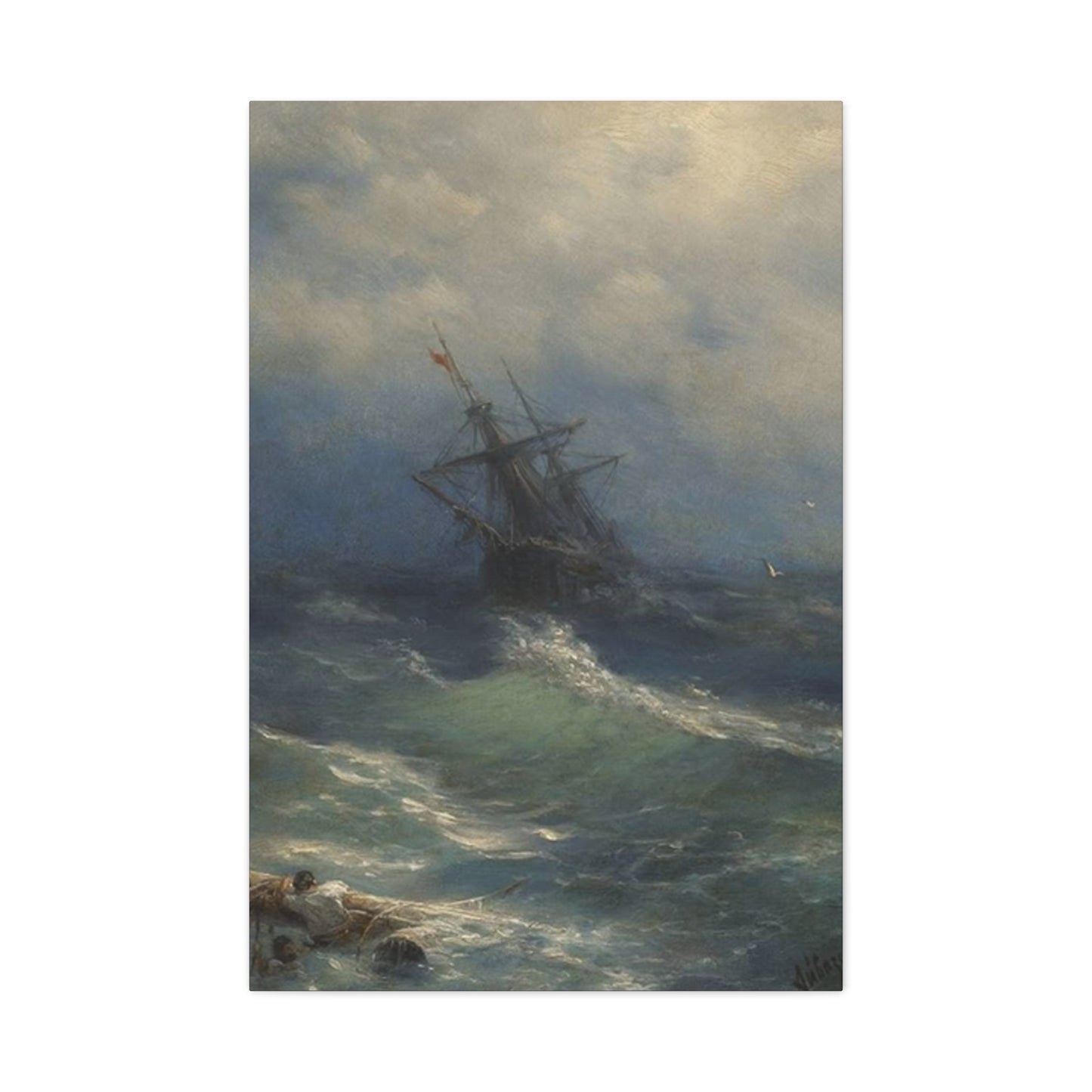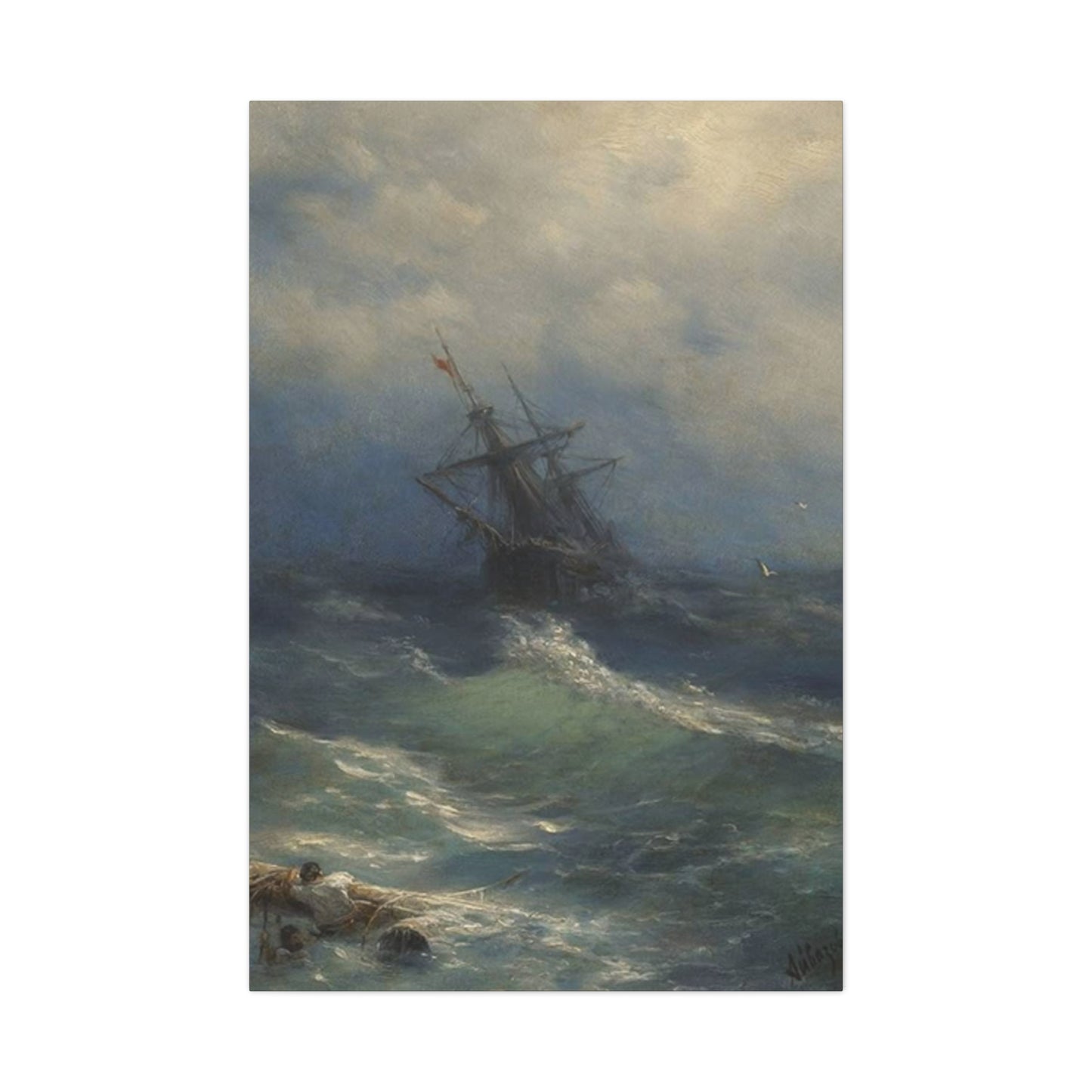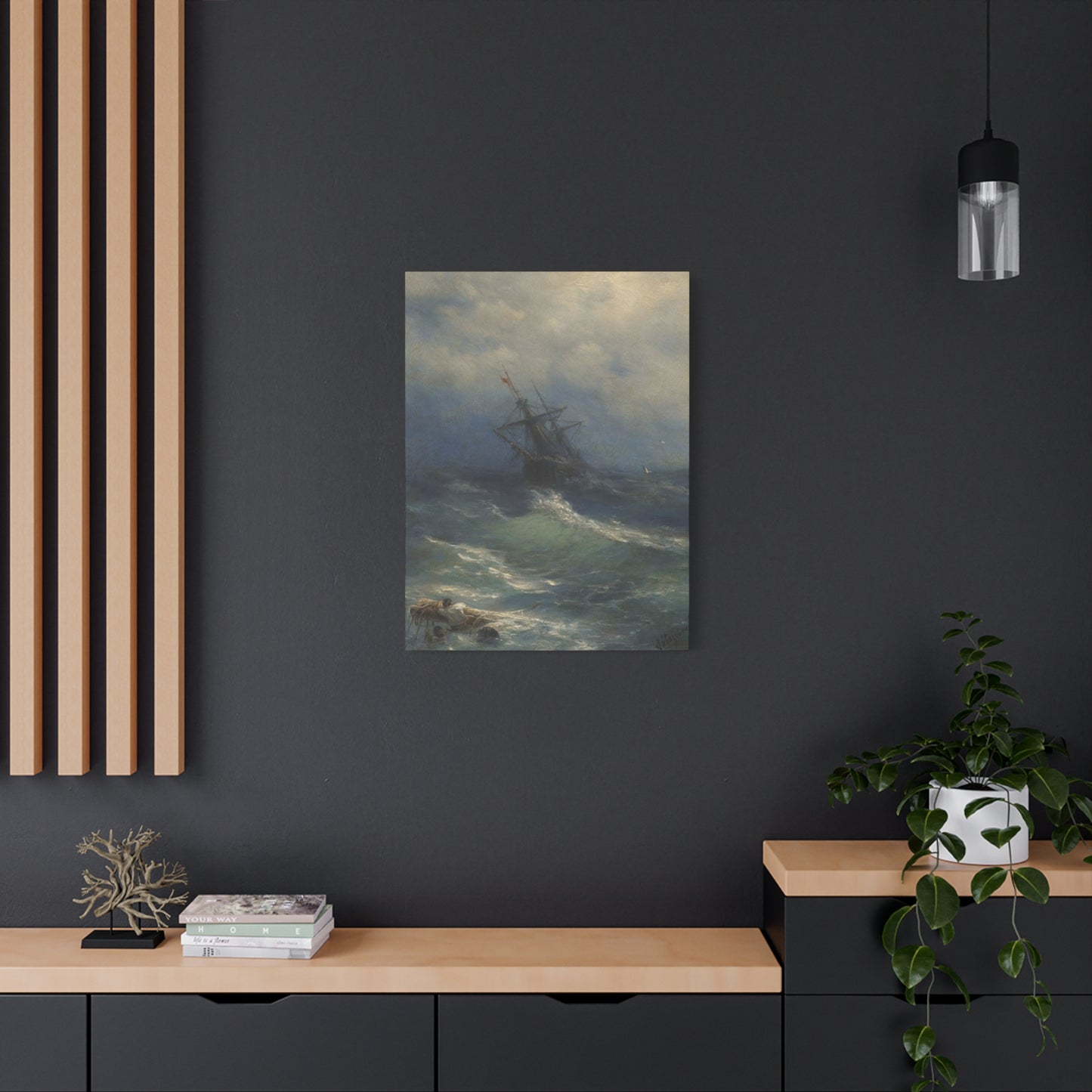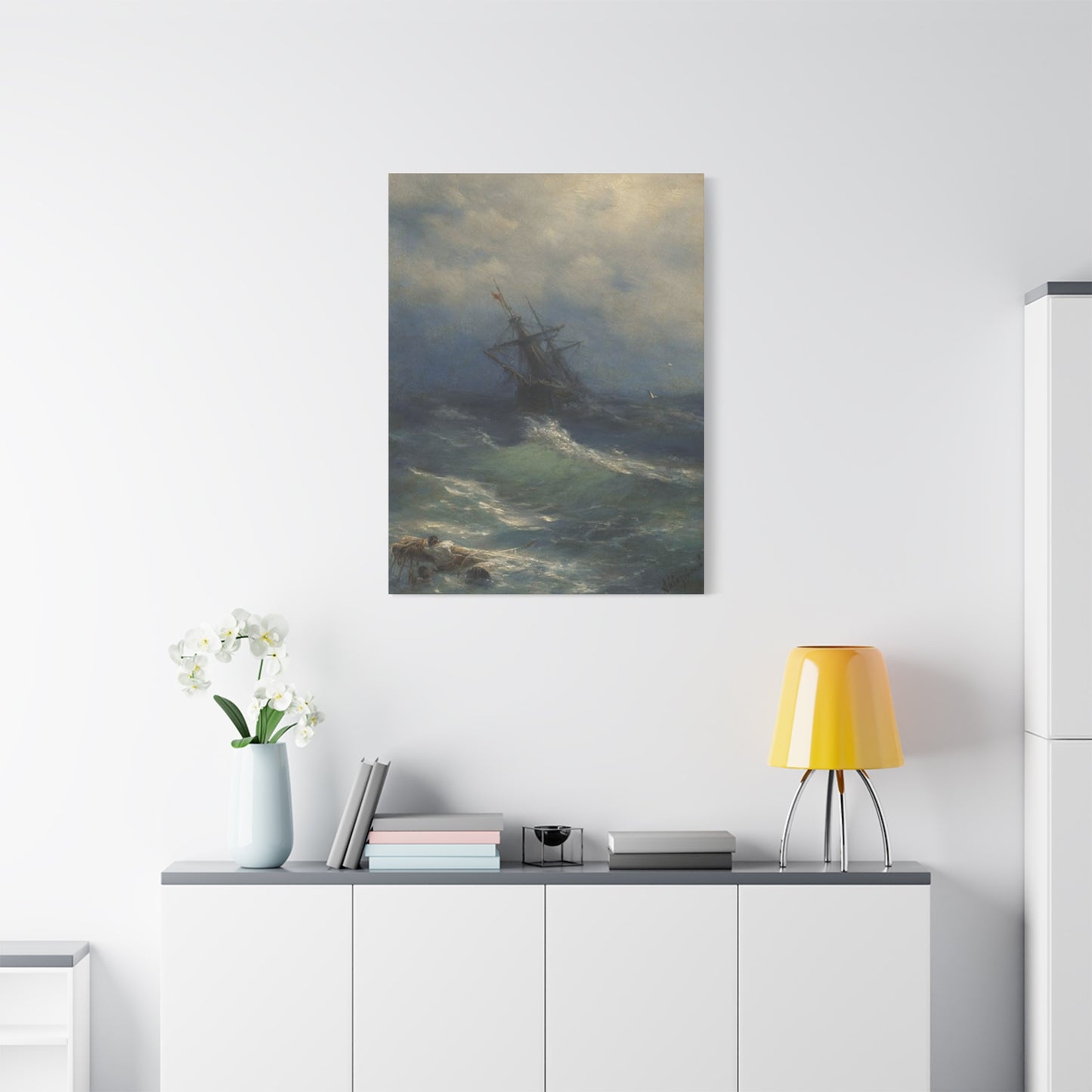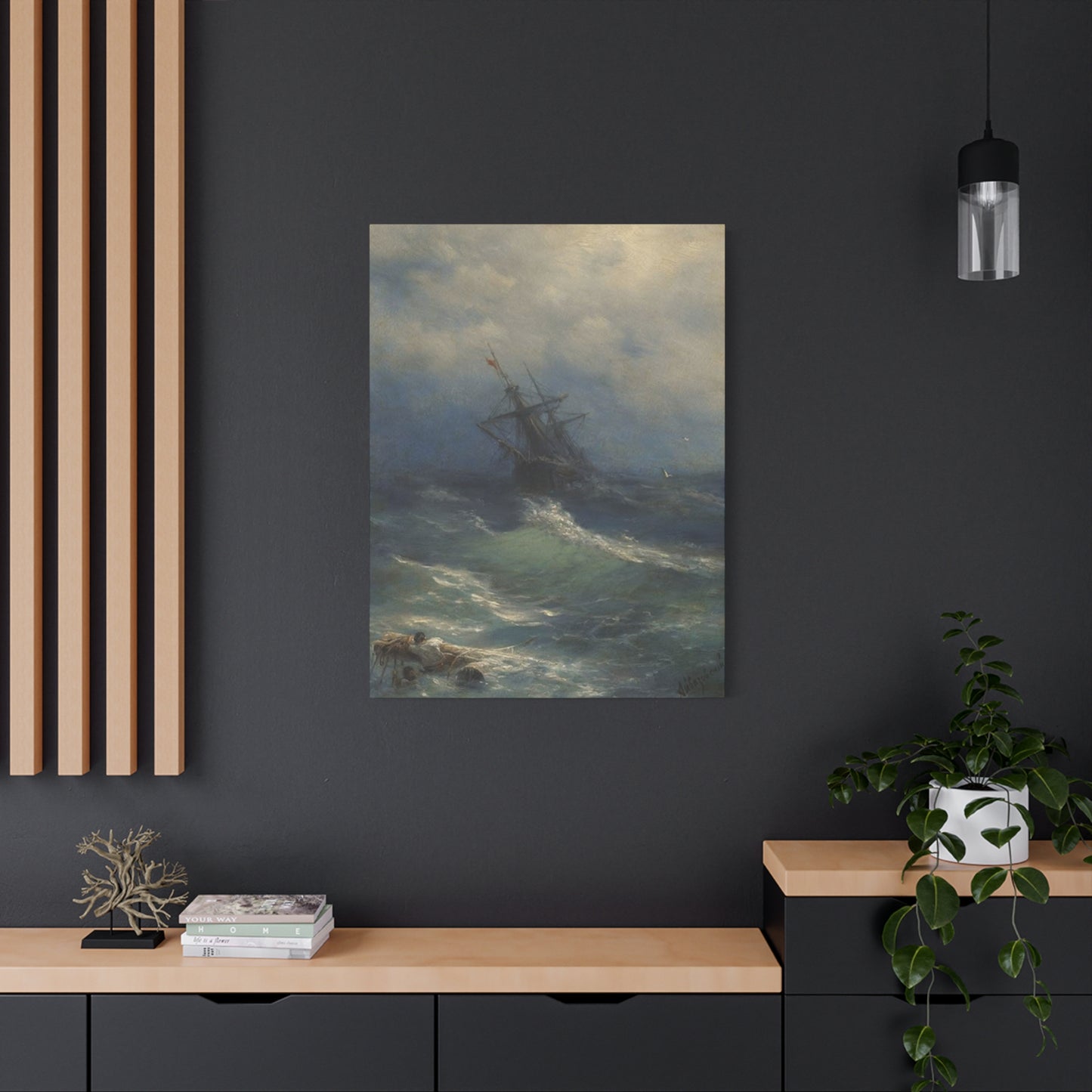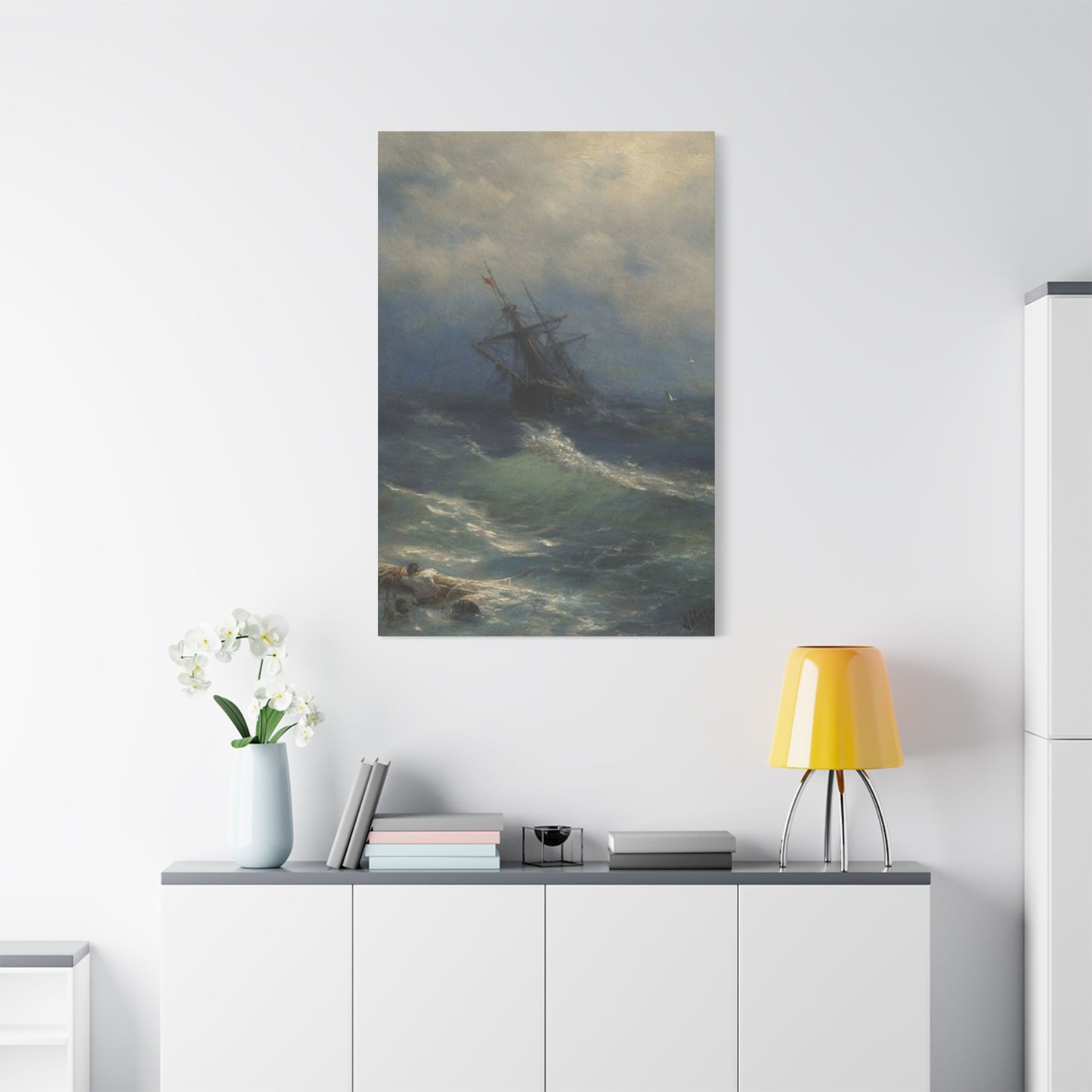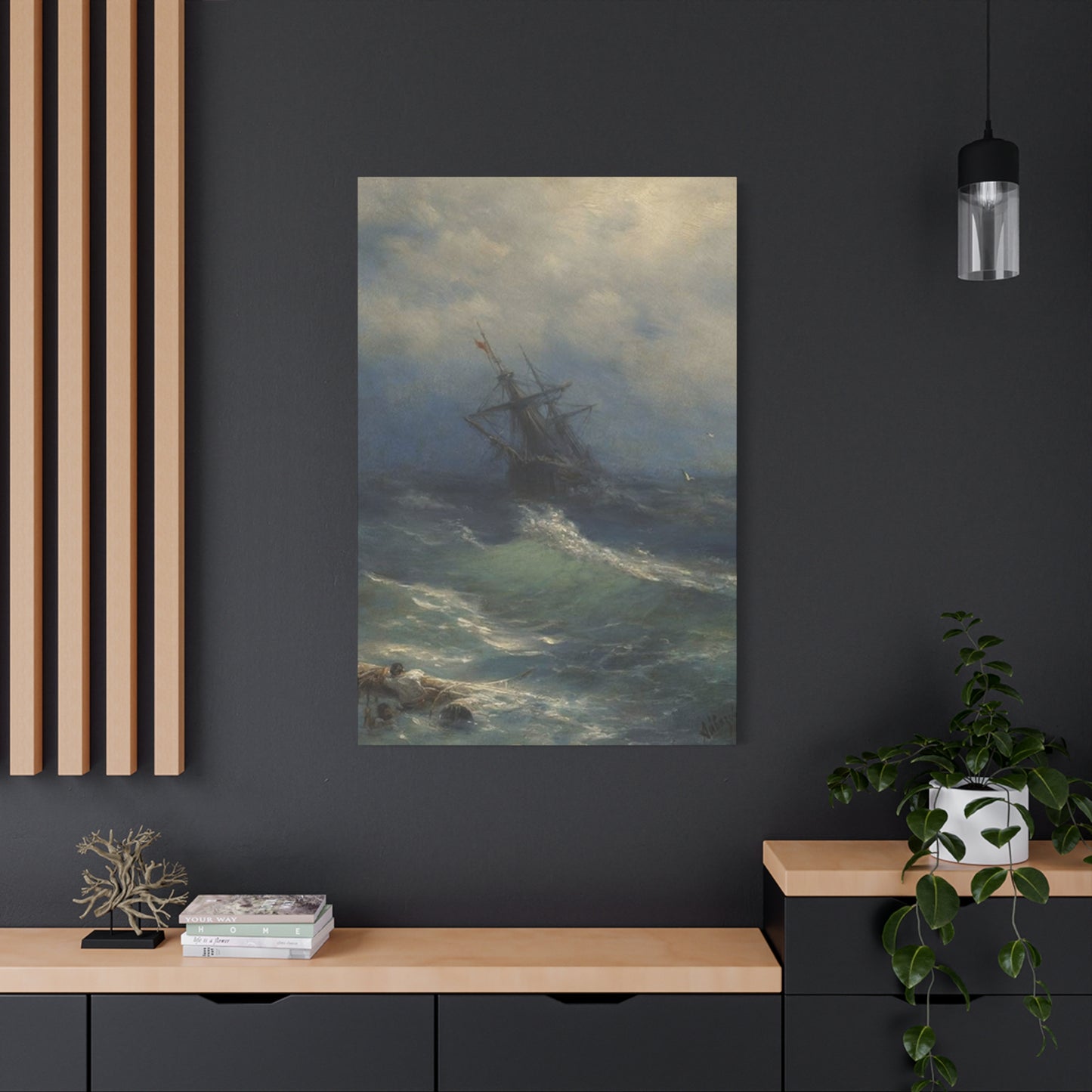Ship at Sea Wall Art: Capturing Motion on Ocean Waves
The vast expanse of oceanic waters has captivated human imagination for millennia, inspiring countless tales of adventure, mystery, and discovery. From ancient mariners who braved uncharted territories to modern sailors navigating turbulent seas, maritime journeys have long symbolized courage, resilience, and the human desire to explore the unknown. The ocean’s ever-changing moods—calm and serene one moment, stormy and powerful the next—have provided endless inspiration for artists, storytellers, and adventurers alike, making it a timeless subject in both literature and visual art.
Ship at sea wall art captures this fascination, offering a visual representation of movement, energy, and the endless possibilities that lie beyond the horizon. Through brushstrokes, color, and composition, artists convey the kinetic motion of waves and the determined progress of ships cutting through them. A carefully rendered piece can evoke the sensation of wind on sails, the rhythmic rise and fall of the ocean, and the exhilarating sense of forward motion that accompanies a vessel on a journey. Such imagery appeals not only to maritime enthusiasts but also to anyone seeking to infuse their space with a sense of adventure, freedom, and dynamic energy.
The aesthetic versatility of ship at sea wall art allows it to complement a wide variety of interior styles. Traditional oil paintings with detailed rigging and textured water bring classic elegance to formal living spaces or offices. Minimalist or abstract interpretations, on the other hand, capture the essence of motion and fluidity with sweeping lines, color gradients, or geometric forms, providing a modern and contemporary touch. Photography-based prints can emphasize realism, highlighting reflections on water, sunlight filtering through waves, or the precise architecture of the ship itself.
Beyond aesthetics, ship at sea artwork carries symbolic significance. Ships navigating vast oceans evoke themes of perseverance, exploration, and personal journeys. Incorporating such pieces into home or office interiors can inspire reflection, ambition, and a connection to the natural world. By combining motion, narrative, and beauty, ship at sea wall art transforms blank walls into immersive experiences, allowing viewers to feel the excitement, power, and mystery of the open ocean every day.
The Allure of Ship at Sea Art
Ships at sea symbolize journey, resilience, and discovery. From historical tall ships braving stormy seas to modern vessels gliding across tranquil waters, the imagery conveys both the physical motion of travel and the emotional motion of adventure and exploration. Wall art that captures these moments allows viewers to connect with these timeless themes, inspiring a sense of awe and wonder.
This type of artwork appeals to a wide range of interior design styles. In coastal homes, it complements nautical décor and marine color palettes, evoking the serenity and energy of ocean life. In modern and minimalist spaces, the dynamic lines of a ship cutting through waves can provide contrast and visual interest. Historical or vintage-inspired interiors benefit from classic maritime paintings that reference exploration, trade, and naval history. The versatility of ship at sea wall art ensures it can enhance spaces ranging from traditional coastal cottages to contemporary apartments.
Capturing Motion: Techniques and Styles
One of the defining qualities of ship at sea wall art is its ability to convey movement. Artists achieve this through various techniques, including the use of brushstrokes, lighting, and perspective. Bold, sweeping brushstrokes can mimic the undulating motion of waves, while carefully rendered sails and hulls create a sense of forward propulsion. In photography or digital prints, motion blur and perspective lines capture the kinetic energy of ships navigating the water, creating a vivid sense of realism.
Different artistic styles offer unique interpretations of the sea’s motion. Realistic oil paintings emphasize intricate details of water texture, ship rigging, and weather conditions. Impressionistic works use color, light, and brushwork to evoke the sensation of movement and atmosphere. Minimalist or abstract representations may focus on geometric shapes, lines, and contrasting colors to convey the rhythm and flow of the ocean, offering a modern twist to maritime décor.
Color Palette and Mood
Color plays a central role in ship at sea wall art. Blues, turquoises, and aquamarines dominate, reflecting the varying moods of the ocean—from tranquil calm to stormy turbulence. Warm tones like sunset oranges, pinks, and golden highlights can be used to depict sunrise or sunset over the horizon, adding a serene and romantic ambiance to the room. Darker tones, including deep navy or stormy grays, evoke drama and intensity, emphasizing the power of the sea and the bravery of the ship and crew.
The choice of color palette directly influences the mood and energy of a space. Cool, muted tones promote relaxation and calm, making them ideal for bedrooms or meditation areas. Vibrant, contrasting colors energize the room and create dynamic focal points in living rooms, offices, or entertainment spaces. By selecting artwork that aligns with the desired atmosphere, homeowners can enhance both aesthetics and emotional impact.
Placement and Interior Integration
Ship at sea wall art is highly adaptable to different interior placements. Large-scale canvas prints or framed paintings serve as statement pieces above sofas, beds, or mantels, drawing attention and anchoring the room’s design. Smaller works can be incorporated into gallery walls alongside complementary maritime-themed elements such as anchors, compasses, or seascape photographs.
Lighting further enhances the impact of maritime wall art. Spotlights or track lighting can highlight textures and reflections on waves, emphasizing the sense of motion. Natural light interacting with the artwork can change its appearance throughout the day, adding depth and intrigue. The strategic placement of ship at sea wall art ensures it contributes to both the visual balance and emotional resonance of the space.
Symbolism and Emotional Connection
Ships navigating the ocean carry rich symbolic meaning. They often represent journeys—literal and metaphorical—highlighting themes of resilience, perseverance, and the pursuit of new horizons. A ship at sea wall art piece can serve as a daily reminder of ambition, adventure, and the courage to face uncertainty. For individuals with a personal connection to the sea, such as sailors, travelers, or maritime enthusiasts, these artworks evoke nostalgia and cherished memories, further enhancing their emotional value.
The dynamic interplay of ship and waves also mirrors life’s rhythm—the calm interspersed with challenges, forward momentum amidst obstacles. This makes ship at sea wall art more than decorative; it becomes an inspiring narrative woven into the interior space, engaging viewers on both a visual and emotional level.
Into the Waves
Venturing into oceanic waters represents one of humanity's most primal and enduring adventures. The sensation of cutting through rolling swells, feeling the spray of salt water against weathered skin, and witnessing the endless expanse of blue stretching toward distant horizons creates an experience that transcends ordinary terrestrial existence. Maritime enthusiasts often describe the moment of departure from safe harbors as transformational, marking the beginning of journeys that test physical endurance, mental fortitude, and spiritual resilience.
The preparation required for oceanic expeditions demands meticulous attention to detail, from selecting appropriate vessels and navigation equipment to provisioning adequate supplies for extended voyages. Experienced sailors understand that the ocean's moods can shift rapidly, transforming calm morning waters into churning afternoon seas that challenge even seasoned mariners. Weather patterns, tidal movements, and seasonal variations all play crucial roles in determining the success and safety of maritime adventures.
Modern technology has revolutionized oceanic navigation, providing sailors with sophisticated instruments for tracking position, monitoring weather conditions, and communicating with shore-based support teams. Global positioning systems, satellite communication devices, and advanced weather forecasting tools have significantly enhanced the safety and accuracy of maritime navigation. However, traditional seamanship skills remain invaluable, as electronic systems can fail in harsh conditions, leaving sailors dependent on compass readings, celestial navigation, and intuitive understanding of wind and wave patterns.
The psychological aspects of oceanic voyaging present unique challenges that distinguish maritime adventures from other forms of exploration. Extended periods at sea, often in confined spaces with limited crew members, require exceptional interpersonal skills and emotional stability. The isolation from familiar surroundings, combined with the constant presence of potential danger, creates psychological pressures that can test even the most experienced adventurers. Successful maritime expeditions depend not only on technical competence but also on the ability to maintain morale, resolve conflicts, and make critical decisions under stress.
Black Sails, Wild Seas
The romance of sailing vessels with dark canvas billowing against storm-laden skies has inspired maritime literature and folklore for centuries. Black sails have historically symbolized rebellion, mystery, and adventure, from pirate ships that terrorized merchant vessels to racing yachts that competed in prestigious regattas. The aesthetic appeal of dark sails against turbulent waters creates dramatic visual contrasts that capture the imagination and evoke feelings of excitement and adventure.
Wild seas present both opportunities and challenges for maritime adventurers seeking authentic oceanic experiences. Rough water conditions test sailing skills, vessel seaworthiness, and crew coordination in ways that calm weather cannot replicate. Experienced sailors often seek out challenging conditions as opportunities to improve their seamanship abilities and experience the ocean at its most powerful and unpredictable. The sound of wind howling through rigging, waves crashing against hulls, and the rhythmic motion of vessels responding to swells creates sensory experiences that define maritime adventure.
The historical significance of black-sailed vessels extends beyond their visual appeal to encompass important cultural and maritime traditions. Pirate ships, naval vessels, and merchant marine fleets have all employed dark sails for practical and symbolic reasons. Black canvas could help vessels remain inconspicuous during nighttime operations, while also serving as intimidating symbols of power and defiance. Modern recreational sailors sometimes choose black sails to honor these maritime traditions while creating distinctive visual statements that set their vessels apart from conventional white-sailed craft.
Safety considerations become paramount when sailing in wild sea conditions, requiring enhanced preparation, equipment maintenance, and crew training. Storm sailing techniques, emergency procedures, and equipment redundancy become critical factors in ensuring successful outcomes during challenging voyages. Experienced mariners develop intuitive understanding of wave patterns, wind shifts, and weather indicators that allow them to anticipate and respond appropriately to changing conditions.
Dark Waters Ahead
The concept of dark waters encompasses both literal and metaphorical interpretations that resonate deeply within maritime culture. Literally, dark waters may indicate deep oceanic regions far from continental shelves, where sunlight penetration decreases and mysterious depths harbor unknown creatures and phenomena. Metaphorically, dark waters represent the unknown challenges, risks, and adventures that await sailors venturing beyond familiar coastal areas into uncharted territories.
Deep ocean environments present unique characteristics that distinguish them from shallow coastal waters. The color of deep water appears darker due to light absorption and scattering properties, creating visual effects that can be both beautiful and intimidating. Marine life in deep waters often differs significantly from coastal species, with adaptations for extreme pressure, limited light, and specialized feeding relationships. Sailors venturing into deep oceanic regions may encounter marine mammals, seabirds, and fish species rarely seen in shallow waters.
Navigation in deep oceanic waters requires different skills and equipment compared to coastal sailing. The absence of visible landmarks necessitates reliance on electronic navigation systems, celestial observations, and dead reckoning techniques. Weather patterns in deep waters can develop and change more rapidly than in coastal areas, requiring constant vigilance and adaptability. Ocean currents, which may be less noticeable near shores, become significant factors affecting vessel speed, direction, and fuel consumption during long oceanic passages.
The psychological impact of sailing in dark waters can be profound, creating feelings of isolation, vulnerability, and awe that transform maritime adventures into deeply personal experiences. Many sailors describe oceanic passages as opportunities for introspection, meditation, and spiritual growth that cannot be replicated in other environments. The vastness of the ocean, combined with the apparent insignificance of human vessels in such immense spaces, often leads to philosophical reflections about humanity's relationship with nature and the universe.
Storm Sailor
Storm sailing represents the pinnacle of maritime adventure, combining technical skill, physical endurance, and mental toughness in ways that few other activities can match. Sailors who specialize in storm conditions develop unique abilities to read weather patterns, handle vessels in extreme conditions, and make critical decisions when survival depends on split-second judgment. The experience of sailing through storms creates lasting memories and builds confidence that extends far beyond maritime activities.
Preparation for storm sailing begins long before weather deteriorates, requiring comprehensive vessel inspections, equipment checks, and crew briefings. Storm sails, safety equipment, navigation instruments, and communication devices must all be tested and positioned for quick access during emergencies. Experienced storm sailors develop detailed contingency plans covering various scenarios, from equipment failures to medical emergencies, ensuring that crews can respond effectively when conditions become challenging.
The physical demands of storm sailing test human endurance in ways that few other activities can replicate. Maintaining balance on pitching decks, handling heavy sails in strong winds, and operating equipment while wearing bulky safety gear requires exceptional fitness and coordination. Sleep deprivation, seasickness, and exposure to cold, wet conditions add additional challenges that must be managed effectively to maintain crew performance and safety throughout storm passages.
Storm sailing techniques differ significantly from fair weather sailing practices, requiring specialized knowledge and skills that can only be developed through experience and training. Heavy weather tactics include reducing sail area, adjusting course to minimize vessel stress, and using sea anchors or drogues to control speed and direction. Understanding wave patterns, wind shifts, and barometric pressure changes becomes crucial for predicting storm development and planning appropriate responses.
The Last Voyage
Every maritime adventure carries elements of finality and transition that give voyages special significance beyond mere transportation or recreation. The concept of a last voyage can apply to retirement expeditions, memorial journeys, or simply the final trip of a particular season or sailing career. These voyages often carry emotional weight and symbolic meaning that transform ordinary maritime activities into profound personal experiences.
Retirement voyages represent common themes in maritime culture, as experienced sailors embark on dream expeditions after years of preparation and anticipation. These final adventures often involve visiting distant destinations, completing circumnavigations, or simply spending extended time on favored cruising grounds. The knowledge that physical abilities or life circumstances may prevent future similar voyages adds poignancy and urgency to these maritime adventures.
Memorial voyages serve as meaningful ways to honor departed friends, family members, or fellow sailors who shared passion for maritime activities. Scattering ashes at sea, visiting meaningful locations, or completing voyages that others could not finish provides comfort and closure while maintaining connections to maritime communities and traditions. These voyages often involve multiple participants sharing memories and celebrating lives lived with connection to oceanic environments.
Planning final voyages requires careful consideration of physical limitations, equipment reliability, and support systems that may be needed during extended expeditions. Older sailors may need to modify traditional sailing practices to accommodate reduced strength, flexibility, or stamina while maintaining safety standards and enjoyment levels. Vessel modifications, crew additions, or route adjustments may be necessary to ensure successful completion of final maritime adventures.
Waves of Silence
The concept of silent waves encompasses moments of profound tranquility that occur during maritime adventures, creating opportunities for meditation, reflection, and spiritual connection with oceanic environments. These periods of calm often occur during dawn or dusk hours when wind subsides, waves flatten, and the ocean surface becomes mirror-like, reflecting sky colors and creating ethereal atmospheres that inspire awe and wonder.
Silent moments at sea provide unique opportunities for experiencing nature without human-made distractions or noise pollution that characterize terrestrial environments. The absence of traffic, construction, and electronic devices allows sailors to hear subtle ocean sounds: gentle wave lapping against hulls, distant seabird calls, and wind whispering through rigging. These acoustic environments can be profoundly restorative, providing mental and emotional benefits that extend long after voyages conclude.
Photography and artistic expression often flourish during silent oceanic moments, as calm conditions provide ideal opportunities for capturing beautiful images and creating lasting memories. The quality of light during sunrise and sunset hours, combined with reflective water surfaces, creates photographic conditions that are difficult to replicate in other environments. Many sailors develop artistic skills specifically to document and share the beauty they encounter during quiet maritime moments.
The spiritual dimensions of oceanic silence have been recognized across cultures and religious traditions throughout human history. Many sailors report experiencing profound sense of connection with nature, universe, or divine presence during quiet moments at sea. These experiences often lead to personal transformation, renewed life perspectives, and deeper appreciation for natural environments and their conservation needs.
Ocean Shadows
The interplay of light and shadow on oceanic waters creates constantly changing visual displays that captivate sailors and inspire artistic expression throughout maritime adventures. Ocean shadows result from cloud formations, land masses, vessel structures, and sail configurations that block or filter sunlight, creating patterns of light and darkness that shift continuously as vessels move and weather conditions change.
Understanding ocean shadow patterns can provide valuable information for navigation, weather prediction, and safety planning during maritime voyages. Shadows cast by clouds often indicate wind patterns, weather fronts, and atmospheric conditions that may affect sailing performance and crew comfort. Experienced sailors learn to read these visual cues as supplements to traditional weather forecasting tools and navigation instruments.
The aesthetic appeal of ocean shadows has inspired maritime artists, photographers, and writers for centuries, providing subjects for creative expression that capture the dynamic beauty of oceanic environments. The interplay between light and dark creates dramatic contrasts that change throughout daily cycles, seasonal variations, and weather conditions, ensuring that ocean shadow patterns remain endlessly varied and interesting.
Ocean shadows also create practical considerations for maritime activities, affecting visibility, temperature regulation, and sailing performance in ways that experienced sailors learn to anticipate and manage. Areas of shadow may provide relief from intense sunlight and heat, while also creating cooler air temperatures that can affect wind patterns and sail efficiency. Understanding these effects helps sailors optimize their performance while maintaining comfort during extended voyages.
Sailing the Tempest
Tempest sailing represents extreme maritime adventure that tests human capabilities and vessel performance under the most challenging oceanic conditions. These intense weather events combine high winds, large waves, precipitation, and atmospheric disturbances that create dangerous but potentially exhilarating sailing experiences for adventurous mariners willing to accept significant risks for extraordinary rewards.
Preparation for tempest sailing requires exceptional attention to safety equipment, emergency procedures, and crew training that goes far beyond normal maritime requirements. Storm sails, safety harnesses, life rafts, emergency beacons, and communication equipment must all be carefully selected, maintained, and positioned for immediate access during crisis situations. Crew members must be trained in heavy weather sailing techniques, emergency response procedures, and first aid protocols that may be needed during tempest conditions.
The physical and psychological challenges of tempest sailing push human endurance to extreme limits, requiring exceptional fitness, mental toughness, and decision-making abilities under severe stress. Maintaining vessel control in high winds and large waves demands constant attention, quick reflexes, and precise coordination between crew members working together under dangerous conditions. Sleep deprivation, seasickness, and fear can impair performance when precise execution becomes critical for survival.
Tempest sailing techniques involve specialized knowledge and skills that can only be acquired through extensive training and experience with progressively challenging conditions. These techniques include storm sail selection and handling, heavy weather steering methods, wave pattern recognition, and emergency damage control procedures. Understanding vessel limitations, crew capabilities, and escape route options becomes crucial for making appropriate decisions about whether to continue sailing or seek shelter during tempest conditions.
Midnight on the Sea
Night sailing presents unique challenges and rewards that distinguish maritime adventures conducted during darkness from daylight voyages. The absence of visual references, combined with altered perception and potential fatigue, creates navigation and safety challenges that require specialized skills and equipment. However, midnight sailing also offers extraordinary experiences, including spectacular starry skies, bioluminescent displays, and profound solitude that many sailors find deeply rewarding.
Navigation during midnight hours requires enhanced reliance on electronic instruments, compass readings, and celestial observations when weather conditions permit star sightings. Radar systems become particularly valuable for detecting other vessels, weather systems, and navigation hazards that may not be visible to naked eyes. Maintaining accurate position fixes and course corrections requires extra diligence when visual references are limited or absent entirely.
Safety considerations during midnight sailing include enhanced lighting systems, crew watch schedules, and emergency response procedures adapted for darkness conditions. Navigation lights, deck illumination, and emergency lighting must all be functional and properly positioned to maintain visibility and safety. Crew fatigue management becomes critical, as sleep deprivation can impair judgment and reaction times when quick decision-making may be essential for avoiding hazards or responding to emergencies.
The aesthetic and spiritual rewards of midnight sailing often compensate for additional challenges and risks associated with nighttime voyages. Clear nights at sea provide unparalleled opportunities for stargazing, with minimal light pollution allowing observation of celestial objects rarely visible from land-based locations. Bioluminescent plankton can create magical displays of blue-green light in vessel wakes and wave crests, while the silence and solitude of nighttime oceanic environments provide meditation and reflection opportunities that many sailors find transformative.
Ship in the Swell
Large oceanic swells represent one of the most distinctive characteristics of deep water sailing, creating rhythmic vessel motion that defines the maritime adventure experience for many sailors. These long-period waves, generated by distant weather systems, can travel thousands of miles across ocean basins while maintaining their energy and creating rolling motion that continues even during periods of light local winds.
Understanding swell patterns and their effects on vessel performance requires knowledge of wave mechanics, weather systems, and sailing techniques that allow mariners to work with rather than against oceanic forces. Experienced sailors learn to read swell direction, period, and height to predict vessel motion and optimize sailing performance for comfort and efficiency. Proper swell technique can improve speed while reducing stress on equipment and crew fatigue during long passages.
The motion characteristics created by oceanic swells can significantly affect crew comfort, safety, and performance during maritime adventures. Some sailors adapt quickly to rolling motion, while others may experience seasickness or discomfort that requires management through medication, dietary changes, or activity modifications. Understanding individual responses to swell motion helps in planning crew assignments and voyage schedules that optimize performance while maintaining safety standards.
Vessel design characteristics significantly influence how ships respond to swell conditions, with different hull shapes, keel configurations, and stability features creating distinct motion patterns and performance characteristics. Deep-keeled sailboats typically provide more stable platforms in swell conditions, while shallow-draft vessels may experience more motion but offer advantages in coastal areas and shallow waters. Selecting appropriate vessels for intended voyage conditions becomes an important factor in planning successful maritime adventures.
Black Hull, Blue Fury
The dramatic contrast between dark vessel hulls and turbulent blue ocean waters creates iconic imagery that captures the essence of maritime adventure and oceanic power. Black hulls have practical advantages including heat absorption for crew comfort in cold climates, reduced maintenance requirements compared to lighter colors, and enhanced visibility of crew members wearing bright safety gear against dark backgrounds.
Blue fury describes oceanic conditions characterized by intense wind, large waves, and turbulent water that creates spectacular displays of natural power while challenging sailors with demanding conditions. These intense oceanic states often produce some of the most memorable and rewarding maritime adventures, combining physical challenge with aesthetic beauty in ways that create lasting impressions and personal growth opportunities.
The psychological impact of experiencing oceanic fury while aboard vessels with dark hulls can be profound, creating feelings of vulnerability and awe that heighten awareness and appreciation for natural forces. Many sailors describe these experiences as transformative, leading to increased confidence, deeper respect for oceanic environments, and enhanced understanding of human relationship with natural world.
Practical considerations for sailing in blue fury conditions include enhanced safety equipment, modified sailing techniques, and careful attention to vessel stress and crew fatigue management. Hull strength, rigging integrity, and sail selection become critical factors in maintaining safety while experiencing the full power and beauty of oceanic fury. Proper preparation allows sailors to enjoy these intense experiences while minimizing risks and maximizing safety margins.
Windswept Destiny
The concept of destiny shaped by wind patterns encompasses both practical navigation considerations and philosophical reflections about how oceanic forces influence human journeys and life directions. Winds determine sailing routes, voyage timing, and destination possibilities in ways that often require adaptation and flexibility from maritime adventurers seeking specific goals or objectives.
Historical maritime expeditions frequently depended on seasonal wind patterns, trade winds, and monsoon cycles that determined optimal sailing schedules and route selections. Understanding these patterns allowed early explorers to plan voyages that took advantage of favorable winds while avoiding periods of calm or adverse conditions. Modern sailors continue to utilize these same wind patterns for efficient passage making and enjoyable sailing experiences.
The metaphorical implications of windswept destiny resonate with many sailors who find that oceanic adventures lead to unexpected opportunities, relationships, and life changes that would not have occurred through other activities. The unpredictable nature of wind and weather requires adaptability and openness that can transfer to other life situations, creating personal growth opportunities that extend far beyond maritime activities.
Planning voyages around wind pattern predictions requires understanding of weather systems, seasonal variations, and climate patterns that affect different oceanic regions throughout annual cycles. Modern weather forecasting provides valuable tools for voyage planning, but experienced sailors also develop intuitive understanding of local conditions and weather signs that supplement electronic forecasting systems.
The Drowned Horizon
The phenomenon of drowned horizons occurs when atmospheric conditions obscure the normal boundary between ocean and sky, creating ethereal environments where usual visual references become unreliable or disappear entirely. These conditions can result from fog, haze, rain, or unusual lighting that creates disorienting but often beautiful oceanic environments that challenge navigation while inspiring awe and wonder.
Navigation in drowned horizon conditions requires enhanced reliance on electronic instruments and compass readings when visual references become unreliable. Radar systems become particularly valuable for maintaining awareness of other vessels, weather systems, and navigation hazards that may not be visible through reduced visibility conditions. GPS systems provide essential position information when celestial navigation becomes impossible due to obscured sky conditions.
The psychological effects of drowned horizon sailing can be profound, creating feelings of isolation, disorientation, and vulnerability that test mental resilience while providing opportunities for personal growth and spiritual reflection. Many sailors describe these experiences as meditative, forcing focus on immediate surroundings and present-moment awareness rather than distant goals or distractions.
Safety considerations during drowned horizon conditions include reduced speed, enhanced watch keeping, sound signals to alert other vessels, and constant monitoring of electronic navigation systems. Emergency equipment must be readily accessible, and crew members should be briefed on procedures for maintaining communication and coordination when visual contact becomes difficult or impossible.
Tide of Darkness
Oceanic darkness encompasses both literal nighttime conditions and metaphorical representations of challenging or mysterious maritime experiences that test sailor courage and determination. The transition from daylight to darkness during oceanic voyages creates dramatic environmental changes that require adaptation in navigation techniques, safety procedures, and psychological preparation for altered sensory conditions.
Tidal movements during darkness hours create additional navigation challenges that require careful attention to current effects on vessel position and course accuracy. Strong tidal currents can significantly affect vessel speed and direction, particularly in coastal areas or narrow straits where current effects may be amplified. Understanding tidal timing and current predictions becomes essential for accurate navigation and voyage planning during darkness hours.
The symbolic aspects of darkness tides relate to challenging periods during maritime adventures when difficulties seem to accumulate and test sailor resolve and capabilities. These metaphorical tides of darkness may include equipment failures, weather deterioration, crew conflicts, or navigation challenges that require persistence and creative problem-solving to overcome successfully.
Emergency preparedness during darkness tides requires enhanced lighting systems, communication equipment, and crew coordination procedures that account for reduced visibility and potentially impaired performance due to fatigue or stress. Having multiple backup systems and well-rehearsed emergency procedures becomes particularly important when normal visual cues are absent and decision-making may be more difficult.
Echoes on the Sea
Sound transmission across oceanic waters creates unique acoustic environments that provide information, entertainment, and sometimes warning signals for maritime adventurers. The ability of sound waves to travel long distances over water surfaces allows communication between vessels, detection of navigation hazards, and appreciation of natural sounds that characterize oceanic environments.
Understanding acoustic properties of oceanic environments helps sailors interpret sounds that may indicate weather changes, marine life activity, vessel traffic, or navigation hazards that require attention. Fog horns, engine sounds, wave patterns, and bird calls all provide valuable information that supplements visual observations and electronic instruments for comprehensive situational awareness during maritime adventures.
The aesthetic aspects of oceanic acoustics contribute to the sensory richness of maritime experiences, providing soundscapes that many sailors find deeply satisfying and memorable. The rhythmic sound of waves against hulls, wind singing through rigging, and distant calls of seabirds create natural music that enhances the emotional and spiritual dimensions of oceanic adventures.
Communication systems for maritime adventures must account for acoustic properties of oceanic environments, including signal propagation characteristics, interference factors, and emergency communication procedures when electronic systems may be unavailable. Traditional sound signals, including horns, bells, and voice communication, remain important backup systems for maritime communication and safety procedures.
The endless expanse of oceanic waters continues to call adventurous souls seeking experiences that cannot be replicated in terrestrial environments. Whether drawn by the challenge of storm sailing, the tranquility of silent waves, or the mystery of dark waters ahead, maritime adventures offer transformative experiences that build character, create lasting memories, and deepen appreciation for the natural world. Each voyage into oceanic realms provides opportunities for personal growth, skill development, and spiritual connection with forces that have shaped human civilization throughout history.
Modern maritime adventures benefit from technological advances that enhance safety and navigation capabilities while preserving the essential elements of challenge and discovery that make oceanic voyages meaningful. The combination of traditional seamanship skills with contemporary equipment creates opportunities for maritime adventures that honor historical traditions while embracing current safety standards and performance capabilities.
The future of maritime adventures will likely continue evolving as technology advances and environmental awareness increases, but the fundamental appeal of oceanic exploration remains constant. The ocean's vast expanse, changing moods, and endless variety ensure that maritime adventures will continue inspiring human imagination and providing transformative experiences for generations of sailors seeking connections with the sea.
From the first tentative ventures into coastal waters to ambitious oceanic expeditions spanning thousands of miles, maritime adventures represent humanity's ongoing relationship with oceanic environments. Each journey contributes to personal development, maritime knowledge, and cultural traditions that preserve and celebrate the enduring appeal of life connected to the sea. The call of oceanic waters remains as compelling today as it was for ancient mariners who first ventured beyond sight of land, seeking adventure, discovery, and transformation through maritime exploration.
Conclusion
Maritime adventures represent far more than mere recreational activities or transportation methods; they embody humanity's deepest connections with oceanic environments and natural forces that have shaped civilization throughout history. From ancient seafaring cultures that developed navigation techniques and vessel designs to modern adventurers utilizing sophisticated technology while preserving traditional seamanship values, the appeal of oceanic exploration continues inspiring generations of maritime enthusiasts seeking transformative experiences beyond terrestrial boundaries.
The diverse aspects of maritime adventures explored in this comprehensive examination demonstrate the complexity and richness of oceanic experiences available to contemporary sailors. Whether pursuing the dramatic intensity of storm sailing, the contemplative tranquility of silent waters, or the mysterious allure of deep oceanic regions, maritime adventures offer unique opportunities for personal growth, skill development, and spiritual connection with natural environments that cannot be replicated through other activities.
The practical considerations involved in planning and executing successful maritime adventures require careful attention to safety equipment, navigation techniques, weather awareness, and crew preparation that distinguishes oceanic voyaging from other forms of adventure travel. The inherent risks and challenges associated with maritime activities demand respect for oceanic forces while providing rewards proportionate to the preparation and skills brought to each voyage. Understanding these requirements allows adventurous individuals to pursue maritime goals safely while maximizing enjoyment and learning opportunities.
The psychological and spiritual dimensions of maritime adventures contribute significantly to their enduring appeal and transformative potential. Extended periods in oceanic environments, removed from terrestrial distractions and immersed in natural rhythms of wind, wave, and weather, provide opportunities for introspection, meditation, and personal development that many participants describe as life-changing. These experiences often lead to increased environmental awareness, enhanced problem-solving abilities, and deeper appreciation for human relationships and natural world connections.
Environmental stewardship represents an increasingly important aspect of contemporary maritime adventures, as sailors witness firsthand the effects of climate change, pollution, and human impact on oceanic ecosystems. Many maritime adventurers become advocates for ocean conservation, sharing their experiences and knowledge to promote responsible interaction with marine environments. This environmental consciousness adds meaning and purpose to maritime adventures while contributing to broader conservation efforts that protect oceanic resources for future generations.
The technological evolution of maritime equipment and navigation systems continues expanding possibilities for maritime adventures while maintaining essential elements of challenge and skill development that define authentic oceanic experiences. Modern sailors benefit from sophisticated weather forecasting, global positioning systems, and emergency communication capabilities that enhance safety without eliminating the fundamental requirements for seamanship knowledge, physical preparation, and mental resilience that characterize successful maritime adventures.
Future developments in maritime adventure opportunities will likely incorporate advancing technology with growing environmental awareness and changing recreational preferences. Sustainable sailing practices, renewable energy systems, and eco-friendly vessel designs represent emerging trends that align maritime adventures with broader environmental goals while preserving the essential elements of challenge and discovery that make oceanic experiences meaningful.
The cultural and historical significance of maritime adventures connects contemporary sailors with maritime traditions spanning millennia of human oceanic exploration. Understanding this heritage adds depth and context to modern maritime activities while preserving valuable knowledge and skills that might otherwise be lost to technological advancement. Maintaining these connections honors the courage and innovation of historical mariners while inspiring contemporary adventurers to continue expanding human understanding of oceanic environments.
In conclusion, maritime adventures offer unparalleled opportunities for personal growth, environmental education, and spiritual development through direct engagement with oceanic forces and natural environments. The combination of physical challenge, mental stimulation, and emotional reward creates experiences that extend far beyond recreational activities to encompass fundamental aspects of human relationship with natural world. Whether pursuing short coastal excursions or ambitious oceanic expeditions, maritime adventures provide pathways to self-discovery, skill development, and environmental awareness that enrich lives while contributing to broader understanding and appreciation of oceanic environments that sustain all life on Earth.


















